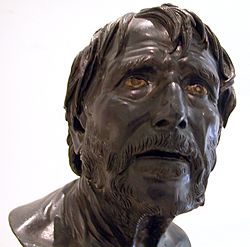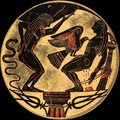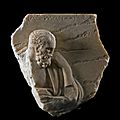Theogony facts for kids
The Theogony (Greek: Θεογονία, Theogonía, the birth of the gods) is a poem by Hesiod. It was written in the 8th or 7th century BC, and uses the same dialect of Ancient Greek as Homer. This dialect is known as Epic dialect today. With the exception of the Illiad and the Odyssey, the Theogony is the oldest known source of Greek mythology.
The poem is a synthesis of different Greek stories and traditions. It is a story that tells how the gods came to be and how they established permanent control over the cosmos. It is the first Greek mythical cosmogony. In the beginning, the state of the universe is chaos - a dark indefinite void. Everything else appeared from divine chaos.
Selected translations
- Most, Glenn, translator, Hesiod, 2 vols., Loeb Classical Library, Cambridge, Massachusetts, 2006-07.
- Schlegel, Catherine M., and Henry Weinfield, translators, Theogony and Works and Days, Ann Arbor, Michigan, 2006
Images for kids
-
The nine muses on a Roman sarcophagus (second century AD)—Louvre, Paris
-
The Birth of Minerva by René-Antoine Houasse (before 1688)
-
Laconic bowl depicting Prometheus and Atlas enduring their respective punishments, circa 550 B.C.
-
Stele of Anaximander, ancient Greek natural philosopher
See also
 In Spanish: Teogonía para niños
In Spanish: Teogonía para niños









